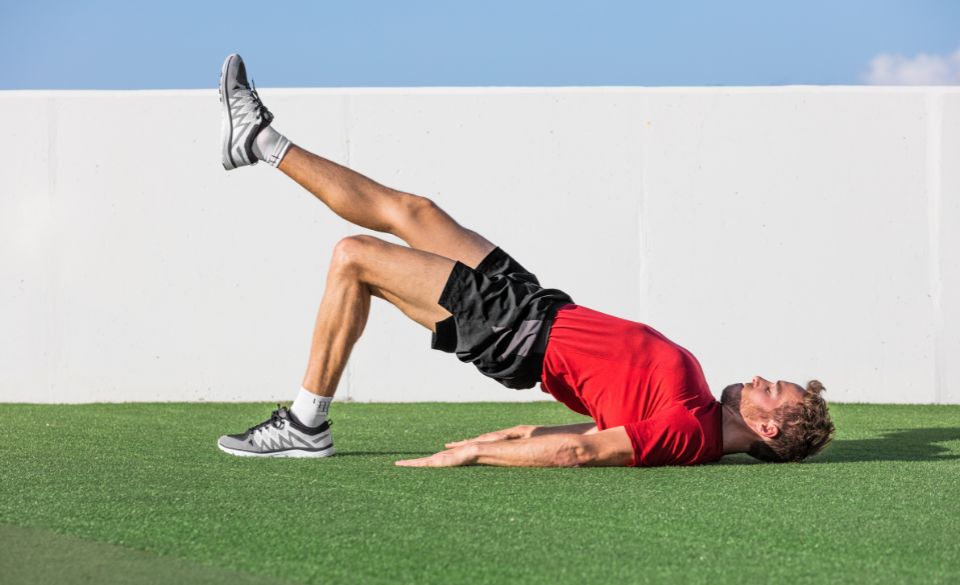
Complete Guide To The Single-Leg Bridge Exercise
Page Contents
The single-leg bridge exercise is a popular lower body exercise that strengthens your glutes, hamstrings, and core. It is a great way to add variety to your workout routine and improve lower body strength and stability.
The single-leg bridge exercise is performed by lying on your back with one foot on the ground and the other leg raised in a bridge position. Keeping the non-working leg on the ground, lift your hips to form a straight line from the knees to the shoulders. Try to keep the hips level and avoid dropping one side of the hip. You can make the exercise harder by straightening the non-working leg and raising it towards the ceiling.
The single-leg bridge is a great exercise for strengthening your core, glutes, and hamstrings. It challenges your balance and stability while working your muscles. It can also help improve hip mobility by strengthening the hip extensors, which can help reduce knee and low back pain.
To perform the single-leg bridge correctly, keep your core engaged throughout the exercise and make sure you do not arch your back. Squeeze your glutes at the top of the movement and slowly lower your hips back to the starting position. To increase the difficulty, you can pause for a few seconds at the top of the exercise or hold a weight.
Overall, the single-leg bridge is an effective and challenging lower body exercise that can help strengthen your core, glutes, and hamstrings. It is a great way to get your heart rate up and improve your balance and stability. Give it a try today and reap the benefits!
How To Do The Single-leg Bridge Exercise
The single-leg bridge exercise is a great way to build strength and stability in your lower body. It targets your glutes, hamstrings, and core muscles, helping to improve your posture and balance. Plus, this exercise can be done anywhere—at home, in the gym, or even outdoors—so there’s no excuse not to give it a try.
To get started, lie on your back with one leg bent and the other leg extended straight up in the air. Rest your arms out to the sides or place them behind your head. This is your starting position.
Next, squeeze your glutes and slowly lift your hips off the ground, forming a bridge with your body. Be sure to maintain a straight line from your shoulders to your knees. Hold this position for a few seconds, then slowly lower your hips back down.
Repeat this exercise 10-15 times, then switch legs and repeat. To make the exercise more challenging, you can add a resistance band or a weight plate to your hips. As you become stronger, you can also increase the number of repetitions and the amount of time you hold the bridge position.
The single-leg bridge exercise is an excellent way to strengthen and tone your lower body. Make sure to keep your form perfect and take your time while performing the exercise to ensure maximum results. With consistency and dedication, you’ll soon see improved strength and balance in no time.
Other Single-Leg Bridge Variations
The single-leg bridge is a great exercise for strengthening the lower body – the glutes, hamstrings, and core are all engaged when performing the exercise correctly. While the traditional bridge is an effective exercise, there can be a lot of room for creativity in terms of variations. Here are a few other single-leg bridge variations that you can incorporate into your workout routine.
1. Weighted Single-Leg Bridge: This variation works the same muscles as the traditional single-leg bridge, but with the added challenge of using a weight or some other form of resistance. You can use a weight plate, a medicine ball, or a barbell to add resistance to the exercise, which will help to increase the intensity of the exercise.
2. Single-Leg Hip Thrust: This variation is similar to the single-leg bridge, but instead of elevating your hips off the ground, you keep them on the ground and simply thrust your hips up as high as possible. This variation is great for strengthening your glutes and hamstrings, and it can also help to improve your balance and coordination.
3. Single-Leg Glute Bridge: This variation focuses on engaging the glutes and hamstrings even more than the traditional single-leg bridge. To perform the exercise, keep one leg in a bent position and press your heel into the ground to raise your hips up off the ground as high as possible. The other leg should remain extended in the air as you perform the exercise.
4. Alternating Single-Leg Bridge: This exercise combines the single-leg bridge and the alternating leg lift. To perform the exercise, start in a single-leg bridge position and then alternate between extending one leg out in front of you and then the other. This variation is great for increasing core stability, balance, and coordination, as well as engaging the glutes and hamstrings.
These are just a few of the many single-leg bridge variations that you can incorporate into your workout routine. Whether you’re looking to increase the intensity of your workout or simply switch things up a bit, these exercises are a great way to do so. Give them a try and take your lower body training to the next level!
The Benefits Of Single-leg Glute Bridge
When it comes to building strength, stability and power in the glutes and hips, the single-leg glute bridge is one of the most effective exercises. The single-leg glute bridge is a popular exercise among athletes, fitness enthusiasts and those looking to strengthen their glutes and hips. In this article, we’ll discuss the benefits of single-leg glute bridges and how they can help improve your performance, health, and overall fitness.
One of the major benefits of the single-leg glute bridge is that it targets the gluteal muscles (or butt) of each leg. The glutes are the largest muscles in the body and are responsible for hip abduction (lifting the leg away from the body) and external rotation of the hip. By specifically targeting these gluteal muscles, you can improve your hip mobility and stability, reduce the risk of injury, and even improve your performance.
Another benefit of single-leg glute bridges is that it can help to strengthen the core. As you perform the exercise, your core has to work hard to keep your body stable and to maintain your balance. This results in improved stability and strength throughout your entire core, which can help to improve your performance with other exercises like squatting, running and jumping.
The single-leg glute bridge also works your lower body muscles, including your quads, hamstrings, and calves. When these muscles are strong and stable, you can move more efficiently and efficiently, which can help you to maximize your performance.
Finally, the single-leg glute bridge can help to improve hip flexibility. As you perform the exercise, your hips are forced to move through their full range of motion, which can help to reduce tightness and improve mobility.
In conclusion, the single-leg glute bridge is a great exercise for building strength, stability, and power in the glutes and hips. It can also help to improve your core strength and lower body muscles, as well as help to improve your hip flexibility. So go ahead and give it a try – you may find it to be one of the most beneficial exercises you can do to improve your performance, health and overall fitness.


